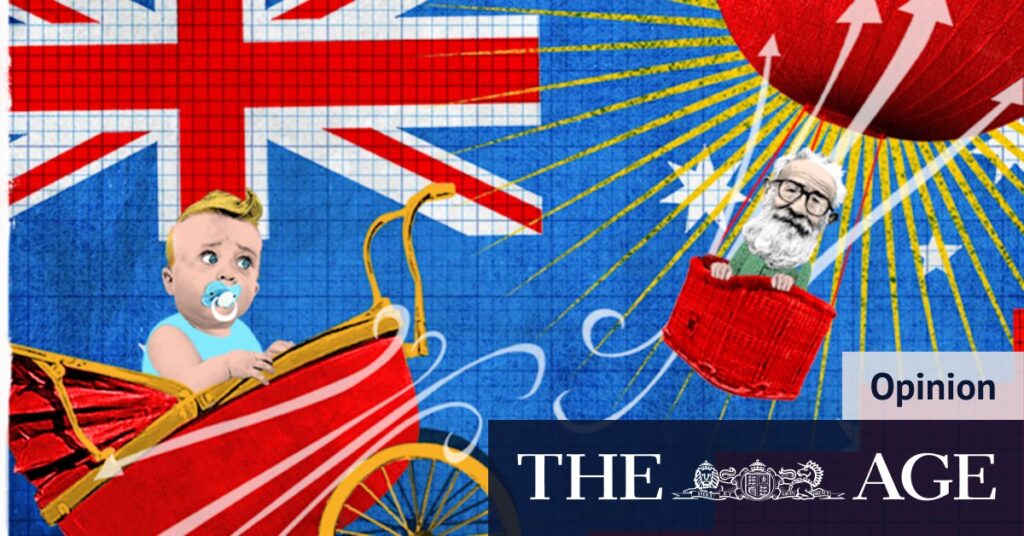
Bridgerton fans may recall the scene where Lady Featherington, eager for a male heir to secure her family’s societal standing, realizes her daughters are clueless about the process of childbirth. This fictional naivety mirrors a real-world misunderstanding among some economists and politicians regarding the critical role of demographics in economic policy.
Many public figures engaged in immigration debates appear as uninformed about the origins of population growth as the Bridgerton ladies. They also seem oblivious to the demographic issue at the opposite end of life: death. Last year, 187,268 Australians passed away, marking the highest number of deaths in a single year outside of 2022, when COVID-related restrictions were lifted.
Since 2011, the retirement of the first Baby Boomers has coincided with a 28% increase in deaths, equating to an additional 40,000 annually. During this period, birth rates have declined, with the number of births dropping by 9,200 or 3%. Australia’s fertility rate has plummeted from 1.92 in 2011 to a record low of 1.48 last year, a decrease of nearly 23%.
Birth-Death Gap: A Shrinking Divide
The gap between births and deaths in Australia remains significant but is rapidly closing. Less than two decades ago, births outnumbered deaths two to one, a ratio that has since vanished with little hope of reversal. While Australia still records more births than deaths, this is not the case in many other countries.
In China, deaths surpass births by 2 million annually. South Korea faces a gap of 120,000, and Japan sees a deficit of about 1 million. Even in the UK, more individuals are dying than being born. The United States and Canada, like Australia, continue to experience more births than deaths, but the gap is narrowing, with deaths now over 80% of births, up from 50% just a few years ago.
Changing Demographics and Their Implications
Australia’s demographic landscape is shifting, with the number of deaths rising and the population aging. The median age at death for Australian men is around 80, while for women, it is 85. The number of people over 80 in New South Wales has doubled since 2000, with Victoria and Queensland experiencing even more significant increases.
This trend is driven by the very old. In 2000, there were 721 centenarians in NSW; last year, there were 2,194. Meanwhile, the number of babies in NSW reached its lowest level since 2006. These changes resemble a tsunami: seemingly slow-moving from afar but rapidly overwhelming when they reach the shore.
Global Responses to Demographic Challenges
Some countries are rushing to address these demographic shifts. Hungary, for instance, offers tax exemptions to mothers with more than two children, yet fertility rates continue to decline. The issues facing Northeast Asia and much of Europe have only recently become apparent, with China’s one-child policy ending in 2015.
The current immigration debate, focusing on whether to reduce or halt it, overlooks the broader demographic equation: declining births and rising deaths. These trends have profound economic and social consequences that remain largely unaddressed.
Economic and Social Ramifications
Depopulation, whether in small towns or entire nations, limits options for those who remain. It affects everything from funding vital infrastructure to staffing aged care facilities. The push from some political quarters to “build stuff” overlooks the demographic changes occurring today.
Australia will increasingly require workers in aged care and health services. As the population ages, more people will need support in retirement communities or their homes. Without adequate care, the nation risks repeating the failures highlighted by the royal commission into aged care.
Rather than focusing on outdated industrial models, Australia will need innovations like electric scooters to help elderly citizens maintain independence and enjoy simple pleasures like a coffee at the local shopping center.
As the demographic landscape evolves, it is crucial for policymakers to consider these changes in their economic and social strategies. Addressing the challenges of an aging population and declining birth rates will require a comprehensive approach that goes beyond immigration policy alone.





